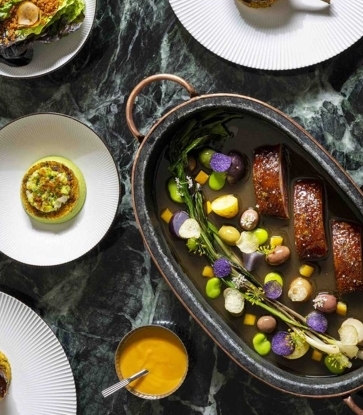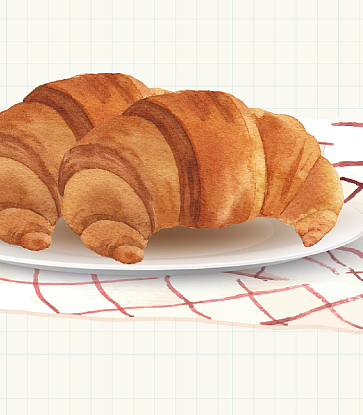
1. Pressed Caviar
Most people fall in love with the mouthfeel of caviar, particularly the delicate pop as the tiny spheres release the briny juices held within. Yet a new product that has caught on in recent years denies diners this very pleasure.
It is called pressed caviar, and it has a pasty texture and a stronger saline taste than regular caviar. It is made by preserving the fish roe in salt and shaping them into a tube or sliced form. To call it new is not entirely correct. According to a 2008 article in Food & Wine magazine by renowned French chef and author Jacques Pépin, pressed caviar was once a fad in France, but it mysteriously disappeared from the market at some point.
Pépin recalls using pressed caviar in the 1950s while working at Parisian restaurant Le Pavilion, and notes that it is a very versatile ingredient. It can be pressed into a thin sheet, cut it into circles or long strips, and dropped onto baked potatoes or omelettes for a touch of luxury. It can even be frozen and shaven onto pasta as a garnish. He also included some personal recipes in his article in the hope that the popularity of pressed caviar would be revived one day.
A decade on, Pépin's sentiments have found resonance in a French chef working in Hong Kong. Olivier Elzer, former head of three-MICHELIN-starred L’Atelier de Joël Robuchon in Hong Kong and currently executive chef French restaurant L’Envol at The St. Regis Hong Kong, recently launched a caviar-themed menu named Prestige. One of the dishes renders pressed caviar into a creamy sauce paired with white wine and butter-cooked razor clams.
Elzer believes he is the first chef in Hong Kong to use pressed caviar. “Options are limited in the market. There are only a few producers who make pressed caviar, and each of them has a slightly different way of production. In comparison to caviar, you can get more creative with pressed caviar. I also like it for its concentrated flavour. It gives the dishes flavours and textures that never existed before.”
He also likes the theatrics of shaving the pressed caviar in front of the diners. In the future, he hopes to discover more ways to use his new favourite ingredient and pioneer its use in the Hong Kong market, he says.

2. Caviar-Infused Rum
Nine out of ten times you would order caviar at a fine dining outlet. The one exception might take place at the newly opened cocktail bar Zest by Konishi in Hong Kong, which serves their caviar in rum. The joint is run by Mitsuru Konishi, the chef who led the former Wagyu Takumi (now Takumi by Daisuke Mori) to MICHELIN-starred fame, while passionate mixologist Jonny Amir fronts the bar counter. One of Amir's creations, the Eau De Mer cocktail, is made with caviar-infused rum. The fish roe's fatty and briny flavour add an intriguing layer to the rum. The addition of white port, house-made seaweed syrup, Roots Mastic liqueur and an extra spoon of caviar lend an extra air of sophistication.
Amir's aim was to design a drink that combined sweet and salty flavours and that would also offer a unique mouthfeel as the guests bite into the caviar while drinking. “It’s not common to use caviar in the cocktail world and it’s not easy to do it well. My inspiration comes from a trip to Martinique, where I saw people pairing rum with seafood dishes,” he said.
Due to the unusual flavour of the beverage, Amir would explain its taste carefully to the guests beforehand to let them know what to expect. According to him, 80 per cent of drinkers love it and would order it again. His next goal is to infuse caviar into other types of alcohols to create a series of martini-style drinks.

3. Ham-Cured Caviar
Caviar is delicious when served on its own, as most restaurants do, but chef Maxime Gilbert from two-MICHELIN-starred Écriture in Hong Kong isn't one for conventions. In his Bone Marrow Soufflé, the caviar is wrapped in ham for 20 to 30 minutes in room temperature to allow the ham’s fat and aroma to transfer onto the caviar.
Gilbert said he first served this dish with caviar straight out of the tin, but felt that something was missing.
He later recalled the Japanese kobujime technique – of curing ingredients between sheets of seaweed – and applied the same principle to his dish. "Caviar should be like other ingredients. It deserves a special preparation method," he said.
“We do multiple trials when creating most of our dishes, but this method only took us one time to get right," said Gilbert, who believes that any type of ham with a decent amount of fat, such as Jamon Iberico Bellota, is a fitting choice. The dish is now served with a surprise: the wait staff would set the ham at the side of the dining table without telling the diners what is inside, unveiling the caviar only after they have finished two to three courses.

4. Caviar From New Origins
Caviar imported from Iran and Russia have typically been regarded as the most superior grade of caviar on the market. But with the declining supply of Russian and Iranian caviar, caviar from new origins have caught on in recent years. Among them, Chinese caviar has come under the spotlight for its high output, affordable price and good quality. Celebrated French chef Alain Ducasse uses it in his restaurants worldwide, prompting a suite of three-MICHELIN-starred establishments from Paris to New York to follow suit.
Currently, 54 per cent of the world’s commercial sturgeon farms are located in China. The brand Ducasse opts for is Kaluga Queen, which has an annual output of 60 tons. It was established in 2003 and has since become a power player in the Chinese caviar sector.
According to the Kaluga Queen’s website, the company has chosen to be based out of Hangzhou's Qiandao Lake because it has “the most beautiful water under the heavens”. The lake has a water surface of 573 square kilometres and 96 per cent forest coverage, and its lack of industrial and agricultural pollution gives the fish a near-natural living environment. Even Ducasse himself praised the lake's water quality after paying the region a visit.

Besides China, Japan is another country that has seen a rise in caviar production. Japan's Miyazaki prefecture was one of six prefectures in Japan gifted a batch of Russian sturgeon fingerlings after a diplomatic exchange with the former Soviet Union. As a result, the Fisheries Research Institute run by the Miyazaki Prefectural Government has been studying sturgeon since 1983. After two decades of research, the first white sturgeons were successfully cultivated in Japan in 2004. The institute spent a further seven extra years to develop a caviar production process based on the traditional European standards.
Of the six prefectures, Miyazaki is the only one that still analyses how to breed and cultivate sturgeon today. The temperature of the region’s natural environment stays at around 17 degrees Celsius all year, which provides the fish a very favourable habitat to produce mild-tasting and smooth fish roe. The caviar is carefully processed with Japanese precision in order to remove all its impurities. The result is one that pleases many chefs in Japan and abroad.
One obstacle for the growth of Miyazaki caviar, however, is its price. According to Japanese newspaper, the Asahi Shimbun, every 20 grams of Miyazaki caviar can cost up to 12,000 yen, or three times as much as its Chinese counterparts. The Miyazaki government has thus made it their goal to increase output and adjust the price, with a view to serving the US and European markets.

5. Snail Caviar
By the strictest definition, caviar refers to the roe of sturgeon fish. But in reality, many restaurants use the term for many other ingredients with the same shape, such as salmon caviar or sodium alginate spheres of olive oil or coffee. Among the spectrum of caviar lookalikes, there is one product that is underrated: escargot caviar.
As its name indicates, escargot caviar is the eggs of snail. Some people prefer it to sturgeon caviar because of its larger size and creamy texture. It has an earthy, woody taste, with hints of mushroom and asparagus. Given its pure translucent colour, some call it “the white pearl on the dining table”.
Although escargot caviar is cheaper than premium Russian sturgeon caviar, but at about SGD$2,700 per kilogram, snail caviar costs over three times as much as farmed sturgeon caviar.





















